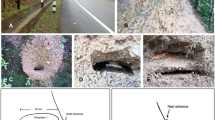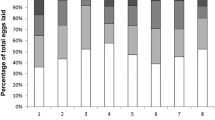Summary
Polygyny and nuptial flight were observed in a supercolony of a Japanese red wood antFormica (Formica) yessensis Forel at Ishikari Coast, Hokkaido, Japan. The main results are:
-
1.
The vertical distribution of queens in nests seasonally fluctuated, preferring deeper parts (mainly 40 to 60 cm below the ground surface) in hibernation season but shallower parts (10 to 40 cm) in summer. This fluctuation was significantly correlative with that of the vertical distribution of workers except mid July to prehibernation season.
-
2.
In nests the queens tended to aggregate with each other at same chambers without hostility. They all had developed ovaries in egg laying season.
-
3.
Abundant sexuals were produced in the average year, but occasional absence of such mass production was also possible.
-
4.
The inseminated new queens tended to return to the mother colony, while most virgins tried to fly away.
Resume
La polygynie et le vol nuptial ont été étudiés dans une super-colonie de fourmis rousses japonaisesFormica (Formica) yessensis Forel à Ishikari Coast, Hokkaido, Japon. Les principaux résultats sont les suivants:
-
1.
La distribution verticale des reines dans les nids varie en fonction de la saison: les reines préfèrent les zones profondes en hiver (40 à 60 cm sous la surface du sol) et les zones peu profondes en été (10 à 40 cm). Cette distribution est positivement corrélée avec celle des ouvrières, excepté entre mi-juillet et la période de pré-hibernation.
-
2.
Dans les nids, les reines tendent à s'agréger dans les mêmes chambres sans hostilité. Toutes ont des ovaires développés pendant la période de production du couvain.
-
3.
La production des sexués est généralement abondante, mais peut parfois faire complètement défaut.
-
4.
Les nouvelles reines «fécondées» tendent à retourner à la colonie-mère, alors que la plupart des femelles vierges essayent de voler plus loin.
Similar content being viewed by others
References
Ehrhardt H.J., 1970 Cited inSchmidt G.H., 1971. — Die Bedeutung von Königinnen mit steter arrhenotoker Parthenogenese für die Männchenerzeugung in den Staaten vonFormica polyctena Förster (Ins. Hym.).Dissertation, Würzburg, Nat. Fak., 1970.
Gösswald K., 1962. — Bildung von Nestablegern beiFormica, Zucht und Anweiselung junger Waldameisen, Königinnen sowie Szenen aus dem Leben der roten Waldameise.Waldhygiene, 4, 153–165.
Higashi S., 1974. — Worker polyethism related with body size in a polydomous red wood ant,Formica (Formica) yessensis Forel.Jour. Fac. Sci. Hokkaido Univ., Ser. VI, Zool., 19, 695–705.
Higashi S., 1976. — Nest proliferation by budding and nest growth pattern inFormica (Formica) yessensis in Ishikari Shore.Jour. Fac. Sci. Hokkaido Univ., Ser. VI, Zool., 20, 359–389.
Higashi S., 1978. — Analysis of internest drifting in a supercolonial antFormica (Formica) yessensis by individually marked workers.Kontyu, 46, 176–191.
Higashi S., Yamauchi K., 1979. — Influence of a supercolonial antFormica (Formica) yessensis Forel on the distribution of other ants in Ishikari Coast.Jap. J. Ecol., 29, 257–264.
Hölldobler B., Wilson E.O., 1977. — The number of queens: an important trait in ant evolution.Naturwissenschaften, 64, 8–15.
Imamura S., 1978. — Adult transport in a supercolony ofFormica (Formica) yessensis Forel, with special reference to its relation with digging.Jap. J. Ecol., 28, 73–84.
Ito M., 1971. — Nest distribution ofFormica yessensis Forel in Ishikari Shore, in reference to plant zonation.Jour. Fac. Sci. Hokkaido Univ., Ser. VI, Zool., 18, 144–154.
Ito M., 1973. — Seasonal population trends and nest structure in a polydomous ant,Formica (Formica) yessensis Forel.Jour. Fac. Sci. Hokkaido Univ., Ser. VI, Zool., 19, 270–293.
Ito M., Imamura S., 1974. — Observations on the nuptial flight and internidal relationship in a polydomous ant,Formica (Formica) yessensis Forel.Jour. Fac. Sci. Hokkaido Univ., Ser. VI, Zool., 19, 681–694.
Schmidt G.H., 1971. — Steuerung der Kastenbildung und Geschlechtsregulation im Waldameisenstaat.Sozial-polymerphismus bei Insekten (Wiss. Verlagsges. m.b.H.), edited by G.H. Schmidt, 404–512.
Author information
Authors and Affiliations
Additional information
Biological and ecological studies of a supercolonial antFormica yessensis Forel, XI.
Rights and permissions
About this article
Cite this article
Higashi, S. Polygyny and nuptial flight ofFormica (Formica) yessensis Forel at Ishikari Coast, Hokkaido, Japan. Ins. Soc 30, 287–297 (1983). https://doi.org/10.1007/BF02223986
Received:
Accepted:
Issue Date:
DOI: https://doi.org/10.1007/BF02223986




